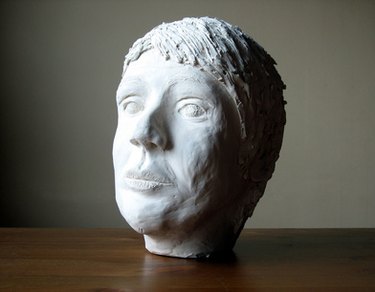
Painting and coloring plaster of Paris is a simple process that allows for lots of creative ideas and easy DIY projects. Plaster of Paris is the mineral gypsum in a dry, powdered form. Mixed with water the plaster can be formed and shaped using molds. When dry the plaster hardens into the mold's shape and can be sanded, carved and painted.
Basic Painting
Video of the Day
Arts and crafts experts seem to agree across the board that painting plaster of Paris is easy when using an acrylic craft paint. Whether decorating a series of plaster Christmas decorations or creating an authentic Egyptian bust, acrylic paint brushes on easily and retains its brilliant colors on plaster of Paris. Water color paint will work too but does not provide the bright, bold color that acrylic paint does. Place a water-based satin or glossy (depending upon the desired final look) acrylic varnish over the painted item to protect the color and prevent dirt and liquids from damaging the surface. Craft books like "Discovering The Magic of Christmas" by Heather Holm or online craft sites like Craft Ideas recommend this basic painting process.
Video of the Day
Antique Techniques
Create authentic looking plaster of Paris game pieces—castles, pyramids, stone buildings—and paint them to look old and antiqued. Hirst Arts provides details on techniques for antique painting plaster of Paris on their website. The techniques can be used for any plaster of Paris item. Painting the item an appropriate under color and then sealing the color is the first step. The items are then stained using shoe polish or gel stains to create a worn, aged look. Hirst recommends under painting a concrete themed item with a light grey and using black shoe polish for the stain. Sand based items should begin with a pale yellow under coat and be stained using brown shoe polish.
Color The Plaster
Add paint to the white plaster and create a solid colored item to avoid the possibility of streaks and pin holes that often happen when the plaster is painted with a brush. Use liquid or powdered fabric dye, powdered or liquid tempera paint, liquid poster paints, powdered acrylic or any non-toxic coloring product (food coloring can be used also). First Palette, a step-by-step kids' crafts website, recommends liquid poster paint be added to the plaster after the plaster is mixed and wet. Combine and mix pigments to create custom colors. Don;t forget to write down color mixing recipes so the colors can be recreated later.